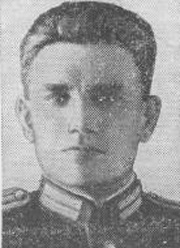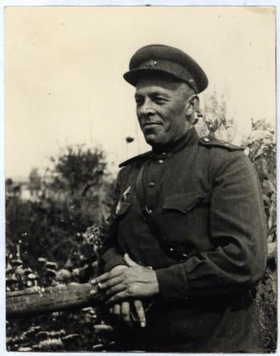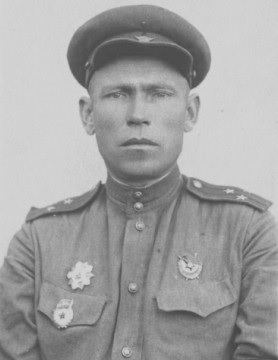The 75th Guards Rifle Division was a Red Army infantry division during World War II and afterwards, which later became the 75th Guards Tank Division and was finally disbanded in the 1990s.
The 14th Rifle Division was an infantry division of the Red Army. Formed in Moscow in 1922, the division spent most of the interwar period at Vladimir. After moving to the Kola Peninsula during the Winter War, the division fought on that front during the Continuation War. After the end of the Continuation War it became the 101st Guards Rifle Division.

Nikolai Nikolayevich Onoprienko was a Red Army colonel and World War II Hero of the Soviet Union. Onoprienko fought in the Battle of Smolensk, the Battle of Moscow, the Battle of Kursk, Operation Kutuzov, Operation Bagration, the East Prussian Offensive and the Berlin Offensive.
The 65th Rifle Division was an infantry division of the Soviet Union's Red Army.
Georgy Filimonovich Kharaborkin was a Red Army captain and a Hero of the Soviet Union. Kharaborkin was awarded the title for his leadership of a tank company in the Winter War, during which his company broke through the Mannerheim Line. He became a battalion commander in the 7th Mechanized Corps' 14th Tank Division after the end of the war. After the German invasion of the Soviet Union in June 1941, Kharaborkin's unit was sent into combat, in an action known as the Lepel counterattack. Before the counterattack began, his corps commander sent Kharaborkin and a dozen heavy tanks on a reconnaissance in force to find fords across a river. The detachment was destroyed on the morning of 6 July when it ran into a German minefield covered by anti-tank guns and artillery, and Kharaborkin was killed.
The 15th Rifle Corps was a rifle corps of the Red Army, formed five times; each formation was a distinct unit unrelated to the others. It was part of the 5th Army. It took part in the Soviet invasion of Poland in 1939.
The 35th Guards Rifle Corps was a rifle corps of the Red Army during World War II that became part of the Soviet Army during the Cold War.
The 409th Rifle Division was as an infantry division of the Red Army from 1941 to 1945. It fought against the German invasion, Operation Barbarossa. It was officially considered an Armenian National division, and initially almost all its personnel were of that nationality. After forming it remained in service along the border with Turkey until nearly the end of 1942, when it was redeployed to the 44th Army in Transcaucasus Front, assisting in driving the German 17th Army into the Kuban peninsula. Following this the division was moved to the 46th Army in Southwestern Front and took part in the summer offensive through the Donbas and eastern Ukraine. In October it was moved again, now to the 57th Army in 2nd Ukrainian Front; it would remain in that Front for the duration of the war, moving to the 7th Guards Army in December. After crossing the Dniepr the 409th won a battle honor in January, 1944, then spent the spring and summer in the battles around Jassy and Kishenev in Moldova. After the defeat of Romania the division advanced into Hungary as part of the 27th Guards Rifle Corps. In October it rejoined the 7th Guards Army, where it remained for the duration, mostly in the 25th Guards Rifle Corps. After the fall of Budapest the division joined the final advances on Vienna and Prague in the spring of 1945, and was disbanded shortly thereafter.
The 414th Rifle Division was twice formed as an infantry division of the Red Army; very briefly in the winter of 1941/42, then from the spring of 1942 until after May 1945. It was officially considered a Georgian National division, having nearly all its personnel of that nationality in its second formation. After its second formation it remained in service in the Caucasus near the borders of Turkey and Iran in the 44th Army until the summer of 1942, when it was redeployed to help counter the German drive toward Grozny. As German Army Group A retreated from the Caucasus in January 1943 the division was reassigned to the 37th Army in North Caucasus Front, and during the fighting in the Taman Peninsula during the summer it served in both the 58th and 18th Armies, earning a battle honor in the process. It entered the Crimea during the Kerch–Eltigen Operation in November, and was awarded the Order of the Red Banner following the offensive that liberated that region in April and May 1944, fighting in the 11th Guards Rifle Corps of the Separate Coastal Army. After the Crimea was cleared the Coastal Army remained as a garrison and the 414th stayed there for the duration of the war. Postwar, it was relocated to Tbilisi, being renumbered as the 74th Rifle Division in 1955 and disbanded the following year.
The 84th Rifle Division was an infantry division of the Red Army before and during World War II.

The 27th Separate Guards Sevastopol Red Banner Motor Rifle Brigade "60th Anniversary of the USSR" is a tactical formation of the Russian Ground Forces. Its Military Unit Number (V/Ch) is 61899. It is part of 1st Guards Tank Army of the Western Military District, stationed in Mosrentgen, Novomoskovsky Administrative Okrug of Moscow.
The 64th Rifle Division was an infantry division of the Red Army during the interwar period and World War II. The division suffered heavy losses in the Battle of Białystok–Minsk but with some troops escaping from encirclement, it was rebuilt in mid-July 1941. For its actions in the Battle of Smolensk it became the elite 7th Guards Rifle Division.

Dmitry Petrovich Monakhov was a Red Army major general who held division and corps command before being killed in World War II.

Mikhail Petrovich Seryugin was a Soviet Army lieutenant general who held division command during World War II.

Aleksei Ivanovich Baksov was a Soviet Army colonel general and a Hero of the Soviet Union.

Aleksandr Borisovich Rodionov was a Red Army colonel who held division commands during World War II.
The 257th Rifle Division was an infantry division of the Red Army, the second unit to bear the designation during World War II. The division joined the 3rd Shock Army and was sent into battle in the Toropets–Kholm offensive in January 1942. Following the conclusion of the offensive, the 257th defended positions northeast of the city of Velikiye Luki for much of the year. For distinguishing itself during the Battle of Velikiye Luki in late 1942 and early 1943, the division was reorganized as the 91st Guards Rifle Division in April 1943.
The May 1943 formation of the 127th Rifle Division was an infantry division of the Red Army, the third unit to bear the designation during World War II.
The 257th Rifle Division was an infantry division of the Red Army, the first unit to bear the designation during World War II.
The following Soviet units fought in the Odessa Offensive between 26 March and 30 April 1944.





